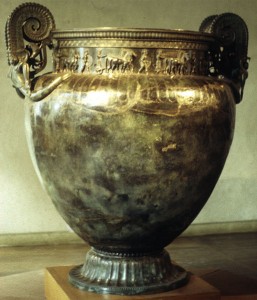Vix Crater

The Vix crater (used for serving wine mixed with water) is the largest metal vessel surviving from the classical world. It was made about 540 BC, probably at Sparta in southern Greece, and was found in 1952 in the grave of an aristocratic woman in Burgundy in eastern France. It emphasises the social importance of alcoholic drink in many different societies. Its transport to France and final location in a grave also symbolises the varied ways that objects can be treated (recycled, curated, deposited) and the increasing divergence of ‘classical’ and ‘barbarian’ worlds in the first millennium BC.
Reading
Lewis, P. A. Greek treasure in France, at: http://www.nytimes.com/1984/04/01/travel/a-greek-treasure-in-france.html?pagewanted=1
Joffroy, R. 1954. Le trésor de Vix, Côte-d’Or. Paris: Presses universitaires de France.

Leave a Reply